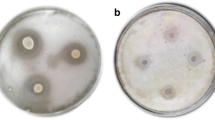Abstract
Many bacterial secondary products are bioactive substances that play an important role in biotechnology and pharmacology (e.g., as antibiotics or antitumor agents). Over the past few years interest in prodigiosin has been increased due to its promising anti-cancer activity. Prodigiosin is also of potential clinical interest because it is reported to have anti-fungal, anti-bacterial, anti-protozoal/anti-malarial, and immunosuppressive activity. Thus there is a need to develop a high-throughput and cost-effective bioprocess for the production of prodigiosin. In the present study, Serratia rubidaea was isolated from colored portion of a spoiled coconut and further it was authenticated by MTCC, India. The various parameters like temperature, pH, salt concentration, and precursors were optimized for the production of prodigiosin. We now report that the pigment production was higher in our isolated strain than S. marcescens. It was observed that prodigiosin binds with plastic, paper, and fibers and thus in near future, it can also be used as a natural dye.










Similar content being viewed by others
References
Wei, Y. H., Yu, W. J., & Chen, W. J. (2005). Enhanced undecylprodigiosin production from Serratia marcescens SS-1 by medium formulation and amino-acid supplementation. Journal of Bioscience and Bioengineering, 100, 466–471. doi:10.1263/jbb.100.466.
Harris, A. K. P., Williamson, N. R., Slater, H., Cox, A., Abbasi, S., Foulds, I., et al. (2004). The Serratia gene cluster encoding biosynthesis of the red antibiotic, prodigiosin, shows species and strain-dependent genome context variation. Microbiology, 150, 3547–3560. doi:10.1099/mic.0.27222-0.
Furstner, A. (2003). Chemistry and biology of roseophilin and the prodigiosin alkaloids: A survey of the last 2500 years. Angewandte Chemie International Edition, 42, 3582–3603. doi:10.1002/anie.200300582.
Montaner, B., & Pérez-Tomás, R. (2001). Prodigiosin-induced apoptosis in human colon cancer cells. Life Sciences, 68, 2025–2036. doi:10.1016/S0024-3205(01)01002-5.
Montaner, B., Navarro, S., Pique, M., Vilaseca, M., Martinell, M., Giralt, E., et al. (2000). Prodigiosin from the supernatant of Serratia marcescens induces apoptosis in haematopoietic cancer cell lines. British Journal of Pharmacology, 131, 585–593. doi:10.1038/sj.bjp.0703614.
Campa’s, C., Dalmau, M., Montaner, B., Barraga’n, M., Bellosillo, B., Colomer, D., et al. (2003). Prodigiosin induces apoptosis of B and T cells from B-cell chronic lymphocytic leukemia. Leukemia, 17, 746–750. doi:10.1038/sj.leu.2402860.
Giri, A. V., Anandkumar, N., Muthukumaran, G., & Pennathur, G. (2004). A novel medium for the enhanced cell growth and production of prodigiosin from Serratia marcescens isolated from soil. BMC Microbiology, 4, 1–10. doi:10.1186/1471-2180-4-11.
Solé, M., Francia, A., Rius, N., & Lorén, J. G. (1997). The role of pH in the “glucose effect” on prodigiosin production by non-proliferating cells of Serratia marcescens. Letters in Applied Microbiology, 25, 81–84. doi:10.1046/j.1472-765X.1997.00171.x.
Khanafari, A., Assadi, M. M., & Fakhr, F. A. (2006). Review of prodigiosin, pigmentation in Serratia marcescens. Online Journal of Biological Sciences, 6, 1–13.
Cappuccino, J. G., & Sherman, N. (2007). Microbiology Laboratory Manual (7th ed.). California: Benjamin Cummings publications.
Soto-Cerrato, V., Llagostera, E., Montaner, B., Scheffer, G. L., & Pérez-Tomás, R. (2004). Mitochondria-mediated apoptosis operating irrespective of multidrug resistance in breast cancer cells by the anticancer agent prodigiosin. Biochemical Pharmacology, 68, 1345–1352. doi:10.1016/j.bcp.2004.05.056.
Thomas, M. G., Burket, M. D., & Walsh, C. T. (2002). Conversion of l-proline to pyrrolyl-2-carboxyl-S-PCP during undecylprodigiosin and pyoluteorin biosynthesis. Chemistry and Biology, 9, 171–184. doi:10.1016/S1074-5521(02)00100-X.
Cerdeno, A. M., Bibb, M. J., & Challis, G. L. (2001). Analysis of the prodiginine biosynthesis gene cluster of Streptomyces coelicolor A3 (2): New mechanisms for chain initiation and termination in modular multienzymes. Chemistry and Biology, 8, 817–829. doi:10.1016/S1074-5521(01)00054-0.
Williamson, N. R., Simonsen, H. T., Ahmed, R. A., Goldet, G., Slater, H., Woodley, L., et al. (2005). Biosynthesis of the red antibiotic, prodigiosin, in Serratia: identification of a novel 2-methyl-3-namyl- pyrrole (MAP) assembly pathway, definition of the terminal condensing enzyme, and implications for undecylprodigiosin biosynthesis in Streptomyces. Molecular Microbiology, 56, 971–989.
Acknowledgments
The authors are thankful to VIT Management for their support and encouragements.
Author information
Authors and Affiliations
Corresponding author
Rights and permissions
About this article
Cite this article
Siva, R., Subha, K., Bhakta, D. et al. Characterization and Enhanced Production of Prodigiosin from the Spoiled Coconut. Appl Biochem Biotechnol 166, 187–196 (2012). https://doi.org/10.1007/s12010-011-9415-8
Received:
Accepted:
Published:
Issue Date:
DOI: https://doi.org/10.1007/s12010-011-9415-8




